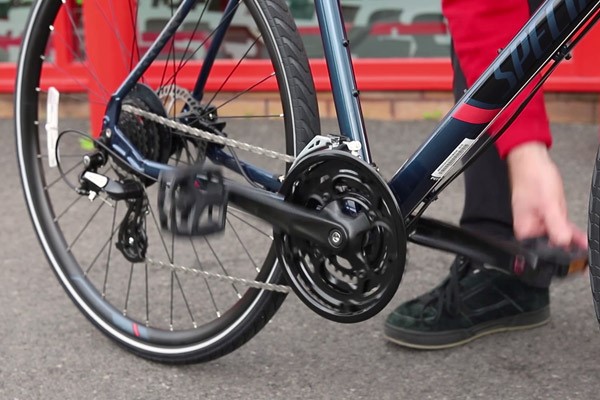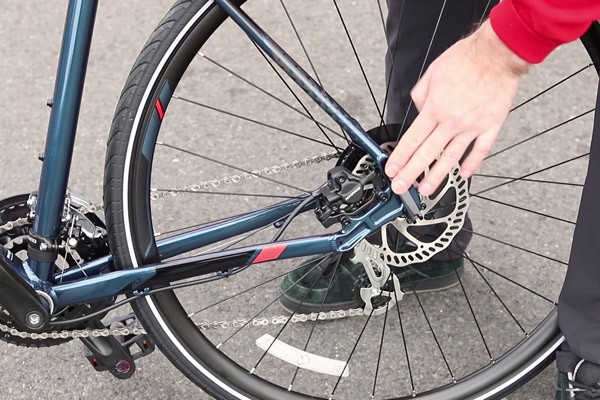The M Check
Before we go cycling we need to make sure our bike is safe to ride. The M-check is a simple way to make sure that all the parts are working properly and our bike is safe before each ride. Starting at the front of the bike and moving in an M shape, we will look at all the essential components at five different points around on the bike.
1Front wheel
Front Wheel - The wheel should be tightly fitted with the quick release axle secure in the closed position. If your bike doesn’t have a quick release axle then check that the nuts or bolts on both sides of the wheel are secure.
Spokes - Check the spokes, they should be of equal tension and not loose or broken.
Tyre pressure - Check that the tyres are properly inflated. Squeeze the tyre, and if soft pump it up – recommended tyre pressures are found on the side wall of the tyre. If the tyre goes soft after pumping it up then you will need to repair it. See our handy how to guide to learn how to fix a puncture.
Tyre damage - Check for wear, bulges or cracks on the side walls of the tyre. If you find significant wear, a crack or a bulge then you should replace the tyre before riding.

2Handlebars and brakes
Front Brake - Hold the front brake and push the bike forward. If the rear wheel lifts off the ground then you can be sure that your brakes are working. If you can push the bike forward with both wheels on the ground then your front brake is not working properly and will need attention before you ride.
Rear Brake - Repeat the process for the rear brake but this time push the bike backwards and see if the front wheel wants to lift off the ground. Again, if you can push the bike backwards with both wheels on the ground then your rear brake isn’t working properly and will need attention before you ride.
Headset – If the headset is working properly then the handlebars will turn easily without any play. Stand beside the bike turn the handlebars 90 degrees. With the brakes on rock the bike back and fore and check for play – you can touch the headset as you do this. If the handlebars feel stiff or there is play where they join the frame then you will need to adjust or replace the headset before you ride.
Brake levers and Shifters - Check the levers and shifters to make sure they are secure, if not then the bolts are too loose and need tightening.
Note: While not required for this quick M-Check, it is a good idea to check the tightness of all the bolts on your bike, with a torque wrench, at regular intervals.

3Chainset
Pedals - Check that the pedals spin freely with no play
Bottom bracket - Check for play in bottom bracket. Grip the crank arm and wobble it, if there is play then the bottom bracket will need attention before you ride.
Drivetrain - Check the drivetrain by spinning cranks backwards. The chain should move smoothly when you do this. If not then pick up rear wheel and spin cranks in correct direction, this will usually put the bike back into gear. Check again by spinning the cranks backwards, if the movement is still not smooth then your drivetrain will need attention before you ride.

4Frame and Saddle
Frame - Look for any damage to the frame, paying special attention to the places where the frame tubes join. If you find any cracks then don’t ride your bike until you have had it checked by a professional mechanic.
Saddle – Check that the saddle is secure and at the correct height. Be sure to check that the seatpost does not exceed its extension limit. Learn how to set your saddle height with our handy video.

5Rear wheel
Rear Wheel – Check that the wheel is tightly fitted with the quick release axle secure in the closed position. If your bike doesn’t have a quick release axle then check that the nuts or bolts on both sides of the wheel are secure.
Spokes – the spokes should be of equal tension and not loose or broken.
Tyre pressure - Squeeze the tyre to see if it is properly inflated. If it is soft pump it up to the recommended tyre pressure found on the side wall of the tyre. If the tyre goes soft after pumping it up then you will need to repair it. See our handy how to guide to learn how to fix a puncture.
Now, if everything checked out ok, you’re ready to go for a ride.





